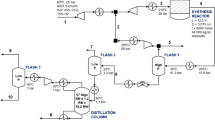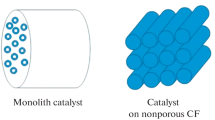Abstract
Fibrous catalysts have shown to enhance mass and heat transfer for fast and exothermic reactions. However, these catalysts can be limited by the pressure drop and achievable productivity, due to the flow rates that can be processed and the catalyst content in the reactor. This paper studies the effect of the geometry of fibrous catalysts on reactor performance by applying them to the reaction of CO2 methanation. A fixed-bed reactor model was used to simulate and study variations in fiber diameter and catalyst coating thickness, and their influence on pressure drop, productivity and reactor efficiency. A comparison basis to traditional pellet catalysts with different reactor configurations is established. Fibrous catalysts show superior reaction heat removal and temperature management, higher catalyst utilization, and smaller catalyst fractions to achieve the intended conversions. Smaller, more compact reactors can be designed thanks to their higher global efficiency. The results show the advantages and versatility of structured ceramic fibrous catalysts, as alternatives for process intensification, and to improve overall reactor performance.





Similar content being viewed by others
Abbreviations
- \({A}_{j}\) :
-
Pre-exponential factor of kinetic constant \({k}_{j}\), units from reference [20]
- \({a}_{\mathrm{gs}}\) (m− 1):
-
Gas–solid interfacial surface area per bed volume
- \(c\) (mol m− 3):
-
Concentration
- \(d\) (m):
-
Diameter
- \({E}_{\mathrm{reactor}}\) (1):
-
Reactor efficiency
- \({\Delta E}_{\mathrm{ext}}\) (1):
-
Efficiency losses due to external mass transfer limitations
- \({\Delta E}_{\mathrm{int}}\) (1):
-
Efficiency losses due to internal mass transfer limitations
- \({\Delta E}_{\mathrm{T}}\) (1):
-
Efficiency losses due to heat transfer limitations
- \(Ea\) (kJ mol− 1):
-
Activation energy
- \({G}_{\mathrm{mol}}\) (mol s− 1 m− 2):
-
Specific inlet molar flow rate
- \(h\) (kW m− 2 K− 1):
-
Heat transfer coefficient
- \(\Delta {H}_{\mathrm{r}}\) (kJ mol− 1):
-
Reaction enthalpy
- \({K}_{i}:\) :
-
Adsorption constant of species \(i\), units from reference [20]
- \({K}_{j}:\) :
-
Equilibrium constant of reaction \(j\), units from reference [20]
- \({k}_{j}:\) :
-
Reaction rate constant for reaction \(j\), units from reference [20]
- \({L}_{\mathrm{R}}\) (m):
-
Reactor length
- \(Nu\) (1):
-
Nusselt number, \(Nu=\frac{h d}{\lambda }\)
- p (kPa):
-
Pressure
- \(P{e}_{T}\) (1):
-
Thermal Péclet number, \(Pe=\frac{d u \rho {c}_{p}}{\lambda }\)
- \(\Delta p\) (kPa):
-
Pressure drop
- \(\Delta p/L\) (kPa m− 1):
-
Pressure drop per unit of length
- \({p}_{i}\) (kPa):
-
Partial pressure of species \(i\)
- \(r\) (mol kgcat − 1 s− 1):
-
Reaction rate
- \(R\) (kJ mol− 1 K− 1):
-
Universal gas constant
- \(RA\) (1):
-
Relative activity
- \(\overline{RA }\) (1):
-
Average relative activity
- \(Re\) (1):
-
Reynolds number, \(Re=\frac{\rho u d}{\mu }\)
- \(T\) (K):
-
Temperature
- \({x}_{\mathrm{cat}}\) (1):
-
Catalyst volumetric fraction in the reactor
- \({y}_{i}\) (1):
-
Molar fraction of species \(i\)
- \(z\) (m):
-
Axial coordinate
- \(\delta \) (m):
-
Layer thickness
- \(\varepsilon \) (1):
-
Porosity
- \(\eta \) (1):
-
Effectiveness factor
- \(\lambda \) (kW m− 1 K− 1):
-
Thermal conductivity
- \(\rho \) (kg m− 3):
-
Density
- \(\tau \) (1):
-
Tortuosity
- 0:
-
Reactor inlet
- B:
-
Bed
- cat:
-
Catalyst
- charact:
-
Characteristic
- eff:
-
Effective
- ext:
-
External
- g:
-
Gas
- gs:
-
Gas–solid
- \(i\) :
-
Species \(i\)
- \(j\) :
-
Reaction \(j\)
- max:
-
Maximum
- p:
-
Particle
- pore:
-
Pore
- s:
-
Solid
- tube:
-
Reactor tube
- w:
-
Wall
References
Matatov-Meytal Y, Sheintuch M (2002) Catalytic fibers and cloths. Appl Catal A 231:1–16. https://doi.org/10.1016/S0926-860X(01)00963-2
Ma Y, Ma Y, Zhao Z, Hu X, Ye Z, Yao J, Buckley CE, Dong D (2019) Comparison of fibrous catalysts and monolithic catalysts for catalytic methane partial oxidation. Renew Energy 138:1010–1017. https://doi.org/10.1016/j.renene.2019.02.027
Cuo Z, Deng Y, Li W, Peng S, Zhao F, Liu H, Chen Y (2018) Monolithic Mn/Ce-based catalyst of fibrous ceramic membrane for complete oxidation of benzene. Appl Surf Sci 456:594–601. https://doi.org/10.1016/j.apsusc.2018.06.207
Jogdand S, Bedadur P, Torris A, Kharul UK, Vasireddy SN, Devi RN (2021) Tuning selectivity of CO2 hydrogenation using ceramic hollow fiber catalytic modules. React Chem Eng. https://doi.org/10.1039/d1re00076d
Tuler FE, Banús ED, Zanuttini MA, Miró EE, Milt VG (2014) Ceramic papers as flexible structures for the development of novel diesel soot combustion catalysts. Chem Eng J 246:287–298. https://doi.org/10.1016/j.cej.2014.02.083
Reichelt E, Jahn M (2017) Generalized correlations for mass transfer and pressure drop in fiber-based catalyst supports. Chem Eng J 325:655–664. https://doi.org/10.1016/j.cej.2017.05.119
Zagoruiko AN, Lopatin SA, Mikenin PE, Pisarev DA, Zazhigalov SV, Baranov DV (2017) Novel structured catalytic systems—cartridges on the base of fibrous catalysts. Chem Eng Process 122:460–472. https://doi.org/10.1016/j.cep.2017.05.018
Lee C, Il J, Shul PYG, Einaga H, Teraoka Y (2015) Ag supported on electrospun macro-structure CeO2 fibrous mats for diesel soot oxidation. Appl Catal B 174–175(185):192. https://doi.org/10.1016/j.apcatb.2015.03.008
Fukahori S, Koga H, Kitaoka T, Tomoda A, Suzuki R, Wariishi H (2006) Hydrogen production from methanol using a SiC fiber-containing paper composite impregnated with Cu/ZnO catalyst. Appl Catal A 310:138–144. https://doi.org/10.1016/j.apcata.2006.05.032
Fukahori S, Koga H, Kitaoka T, Nakamura M, Wariishi H (2008) Steam reforming behavior of methanol using paper-structured catalysts: experimental and computational fluid dynamic analysis. Int J Hydrogen Energy 33:1661–1670. https://doi.org/10.1016/j.ijhydene.2007.12.063
Saimura A, Kitaoka T (2016) Paper-structured catalysts with porous fiber networks for fischer-tropsch synthesis. J Korea TAPPI 48:32–45. https://doi.org/10.7584/JKTAPPI.2016.12.48.6.32
Sánchez A, Milt VG, Miró EE, Güttel R (2020) Ceramic fiber-based structures as catalyst supports: a study on mass and heat transport behavior applied to CO2 methanation. Ind Eng Chem Res 59:16539–16552. https://doi.org/10.1021/acs.iecr.0c01997
Sánchez A, Milt VG, Miró EE, Güttel R (2022) Impact of heat transport properties and configuration of ceramic fibrous catalyst structures for CO2 methanation: a simulation study. J Environ Chem Eng 10:107148. https://doi.org/10.1016/j.jece.2022.107148
Ghaib K, Nitz K, Ben-Fares F-Z (2016) Chemical methanation of CO2: a review. ChemBioEng Rev 3:266–275. https://doi.org/10.1002/cben.201600022
Thema M, Sterner M, Lenck T, Götz P (2016) Necessity and impact of power-to-gas on energy transition in Germany. Energy Procedia 99:392–400. https://doi.org/10.1016/j.egypro.2016.10.129
Chauvy R, Dubois L, Lybaert P, Thomas D, De Weireld G (2020) Production of synthetic natural gas from industrial carbon dioxide. Appl Energy 260:114249. https://doi.org/10.1016/j.apenergy.2019.114249
Cybulski A, Eigenberger G, Stankiewicz A (1997) Operational and structural nonidealities in modeling and design of multitubular catalytic reactors. Ind Eng Chem Res 36:3140–3148. https://doi.org/10.1021/ie960596s
Eigenberger G, Ruppel W (2012) Catalytic fixed-bed reactors. Ullmann’s Encycl Ind Chem. Wiley-VCH, Weinheim
Schlereth D, Hinrichsen O (2014) A fixed-bed reactor modeling study on the methanation of CO2. Chem Eng Res Des 92:702–712. https://doi.org/10.1016/j.cherd.2013.11.014
Xu J, Froment GF (1989) Methane steam reforming, methanation and water-gas shift: I. Intrinsic kinetics. AIChE J 35:88–96. https://doi.org/10.1002/aic.690350109
Güttel R, Turek T (2016) Improvement of fischer-tropsch synthesis through structuring on different scales. Energy Technol 4:44–54. https://doi.org/10.1002/ente.201500257
Gao J, Wang Y, Ping Y, Hu D, Xu G, Gu F, Su F (2012) A thermodynamic analysis of methanation reactions of carbon oxides for the production of synthetic natural gas. RSC Adv 2:2358–2368. https://doi.org/10.1039/c2ra00632d
Massa F, Coppola A, Scala F (2020) A thermodynamic study of sorption-enhanced CO2 methanation at low pressure. J CO2 Util 35:176–184. https://doi.org/10.1016/j.jcou.2019.09.014
Dietrich B (2013) Heat transfer coefficients for solid ceramic sponges—experimental results and correlation. Int J Heat Mass Transf 61:627–637. https://doi.org/10.1016/j.ijheatmasstransfer.2013.02.019
Gao J, Liu Q, Gu F, Liu B, Zhong Z, Su F (2015) Recent advances in methanation catalysts for the production of synthetic natural gas. RSC Adv 5:22759–22776. https://doi.org/10.1039/c4ra16114a
Woods DR (2007) Rules of thumb in engineering practice. Wiley-VCH, Weinheim
Wallenstein M, Kind M, Dietrich B (2014) Radial two-phase thermal conductivity and wall heat transfer coefficient of ceramic sponges—experimental results and correlation. Int J Heat Mass Transf 79:486–495. https://doi.org/10.1016/j.ijheatmasstransfer.2014.08.003
Kashid MN, Renken A, Kiwi-Minsker L (2014) Microstructured devices for chemical processing. Wiley-VCH, Weinheim
Kaiser S, Reichelt E, Gebhardt SE, Jahn M, Michaelis A (2014) Porous perovskite fibers—preparation by wet phase inversion spinning and catalytic activity. Chem Eng Technol 37:1146–1154. https://doi.org/10.1002/ceat.201400097
Tuler FE, Gaigneaux EM, Miró EE, Milt VG, Debecker DP (2015) Catalytic ceramic papers for diesel soot oxidation: a spray method for enhanced performance. Catal Commun 72:116–120. https://doi.org/10.1016/j.catcom.2015.09.013
Sacco N, Banús E, Milt V, Miró E, Bortolozzi JP (2020) Catalytic paper filters for diesel soot abatement: studies at laboratory and bench scales. Emiss Control Sci Technol 6:450–461. https://doi.org/10.1007/s40825-020-00169-9
Ahlström-Silversand AF, Odenbrand CUI (1997) Thermally sprayed wire-mesh catalysts for the purification of flue gases from small-scale combustion of bio-fuel catalyst preparation and activity studies. Appl Catal A. https://doi.org/10.1016/S0926-860X(96)00329-8
Garbarino G, Bellotti D, Riani P, Magistri L, Busca G (2015) Methanation of carbon dioxide on Ru/Al2O3 and Ni/Al2O3 catalysts at atmospheric pressure: catalysts activation, behaviour and stability. Int J Hydrogen Energy 40:9171–9182. https://doi.org/10.1016/j.ijhydene.2015.05.059
Alrafei B, Polaert I, Ledoux A, Azzolina-Jury F (2020) Remarkably stable and efficient Ni and Ni-Co catalysts for CO2 methanation. Catal Today 346:23–33. https://doi.org/10.1016/j.cattod.2019.03.026
Woodside W, Messmer JH (1961) Thermal conductivity of porous media. I. Unconsolidated sands. J Appl Phys 32:1688–1699. https://doi.org/10.1063/1.1728419
Bremer J, Sundmacher K (2021) Novel multiplicity and stability criteria for non-isothermal fixed-bed reactors. Front Energy Res 8:1–19. https://doi.org/10.3389/fenrg.2020.549298
Fendt S, Buttler A, Gaderer M, Spliethoff H (2016) Comparison of synthetic natural gas production pathways for the storage of renewable energy. WIREs Energy Environ 5:327–350. https://doi.org/10.1002/wene.189
Molino A, Nanna F, Ding Y, Bikson B, Braccio G (2013) Biomethane production by anaerobic digestion of organic waste. Fuel 103:1003–1009. https://doi.org/10.1016/j.fuel.2012.07.070
Meyer D, Schumacher J, Friedland J, Güttel R (2020) Hydrogenation of CO/CO2 mixtures on nickel catalysts: kinetics and flexibility for nickel catalysts. Ind Eng Chem Res 59:14668–14678. https://doi.org/10.1021/acs.iecr.0c02072
Funding
The authors acknowledge the financial support received from Agencia Nacional de Promoción Científica y Tecnológica (ANPCyT, Grant PICT 2016 N°2710), Consejo Nacional de Investigaciones Científicas y Técnicas (CONICET, Grant PIP 2015), and Deutscher Akademischer Austauschdienst (DAAD, CUAA-DAHZ, Grant D/14/07554).
Author information
Authors and Affiliations
Contributions
AS: Conceptualization, methodology, investigation, visualization, writing—original draft preparation. VGM: Conceptualization, writing—review & editing, supervision, EEM: Conceptualization, writing—review & editing, supervision. RG: Conceptualization, writing—review & editing, supervision.
Corresponding author
Ethics declarations
Conflict of interest
The authors have no competing interests to declare that are relevant to the content of this article.
Additional information
Publisher's Note
Springer Nature remains neutral with regard to jurisdictional claims in published maps and institutional affiliations.
Supplementary Information
Below is the link to the electronic supplementary material.
Rights and permissions
About this article
Cite this article
Sánchez, A., Milt, V.G., Miró, E.E. et al. Simulation Study of Ceramic Fibrous Structured Catalysts for CO2 Methanation—Enhancement of the Performance and Comparison to Pellet Catalysts. Top Catal 65, 1317–1330 (2022). https://doi.org/10.1007/s11244-022-01675-6
Accepted:
Published:
Issue Date:
DOI: https://doi.org/10.1007/s11244-022-01675-6




